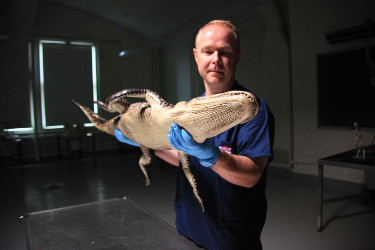Molecular Palaeontology
Recognition of endogenous biomaterials in fossil remains has long been a goal for palaeobiology. A suite of new analytical techniques is now providing the tools that permit such work to be undertaken on dilute biomarkers preserved in the fossil record.

This research concentrates on the study of bone collagen (I), because of its greater persistence in fossilised remains. Members of the group are further developing ZooMS (‘Zooarchaeology by Mass Spectrometry’), in which collagen peptides are fractionated by SPE and fingerprinted using MALDI-TOF-MS. Typical palaeontological and archaeological applications are to distinguish between morphologically-similar taxa such as the caprine species, sheep and goats, or the identification of taxa in limited but highly assemblages spanning much of the Pleistocene.
This research uses protein separation and analysis techniques, namely various forms of liquid chromatography coupled with 'soft-ionization' mass spectrometry, to investigate degraded tissues ranging from archaeological and palaeontological burial environments to processed foods. The 'soft-ionization' methods we typically use are Matrix Assisted Laser Desorption Ionization (MALDI) for high-throughput peptide mass fingerprinting (PMF) of samples, and Electrospray Ionization (ESI), which we dedicate for more in-depth sequence analysis. It is the 'soft-ionization' that allows for the analysis of large biomolecules without inducing excessive fragmentation prior to analysis and detection in the mass spectrometer, ideal for studying low quantities of ancient and degraded proteins.



